What Is Credibility In Business
Establish Business Credibility and Build Trust: Best Practices and Tips For eCommerce Merchants

What happens in people's minds upon entering your store? – How is your business credibility? Are you trusted?
Before you can start listing benefits and features, people made a snap judgment whether you are credible or not. Business credibility is meant to do its magic at moments like this. It's the glue that binds companies to their customers and to the communities where they operate.
Trust is something that's earned, and hardest when you don't have any customers yet. You might have to give before you get.
In this article, you will find a compiled list of the Stanford team's ideas with our team's research, to give you the most updated and inclusive view about building business credibility most adeptly.
01. What Is Business Credibility?
Credibility is the quality of being trusted by a specific group of people. In terms of conversion rate optimization, business credibility is defined as the quality of being trusted by your target customers.
Ideally, customer's trust is expressed through positive behavior towards your brand, of which the final outcome is an increased conversion rate.
02. Why You Should Build Business Credibility
We are living in a time when everything is commercialized and everyone wants to sell us something – especially corporations. Therefore, interestingly, human brains react in a more or less "passive-aggressive" way to this scenario – we consumers tend to distrust brands at first glance. Because we believe their goal, after all, is to make money.
A consumer trust crisis is on the rise, targeting big corporations and small local businesses alike. Prime examples are unfortunately not hard to find, as Johnson & Johnson brand are just recovering from long-running court battles and a historical $40 billion loss in market value which all started since a Reuters report was released to the public. According to PwC's Global Consumer Insights Survey in 2018, more than one in three consumers ranked "trust in brand" as among their top three reasons that influence their decision to shop at a particular retailer, other than price.

The need to build brand trust is even more important now due to the immediate effect of social media on every aspect of consumers' lives, including their spending choices and habits. And it's not just observation, PwC confirmed that social networks are the most influential when finding inspiration to buy products – at 37%, followed by individual retailer websites and price comparison websites.
If you already have a solid track record of brand trust and business credibilitybehind you, like Google, Amazon, or Apple; or you got some glorious case studies and testimonials to show, you're in a great place. Customers are more likely to buy products from and root for businesses that they trust. Companies interested in lasting for the long-term understand that maintaining trust translates to a stronger brand reputation, a more reliable "social" license to operate, and an ability to attract and retain talent and capital.
But what if you don't have anything yet?
Imagine opening your new online store for the very first time. You've got no sales, no reviews, no social proof, no loyal customers yet. You've only got yourself with quality products to serve – how can you bridge the gap in trust to grow confidence in potential customers?
03. How To Build Business Credibility
It takes about 50 milliseconds (that's 0.05 seconds) for users to form an opinion about your website that determines whether they like your site or not, whether they'll stay or leave, so yes – they are judging a book by its cover. Plus, a 10-year analysis by Fortune.com has shown that public trust in a company and profitability are closely positively connected. You gotta act quick.
3.1. Show business traction
Show that there's a real organization behind your site. Make your site personable by posting pictures of real people. Who started your business? Tell the story about why and how your business was started.
Learn to recognize achievements in your business. Put them front and center for all to see. Numbers help but put them into context to boost understanding. Consider how you can add specifics. Think about technical data, user numbers, where exactly you source your material, what specific material you use, numbers of testers, number of days it took to develop your product, etc.
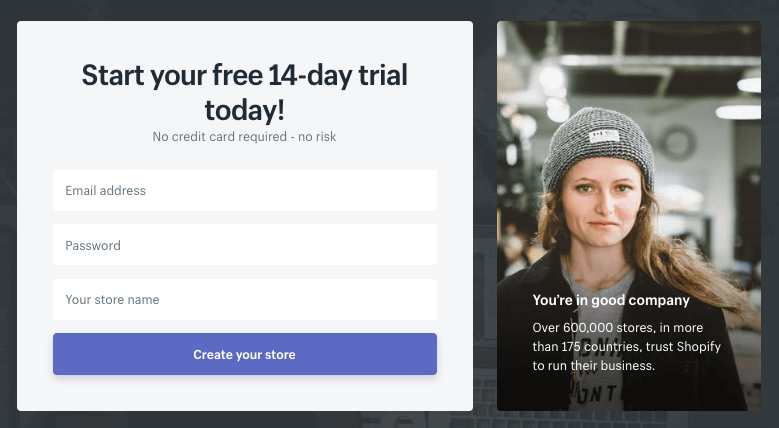
Numbers attract attention because they stand out in your copy. Compare these two statements:
- Eight million people use our widgets
- 8,000,000 people use our widgets
The number 8,000,000 attracts more attention than the word eight million, but how do you measure 8,000,000 really? Instead of just quoting a number, relate it to something people know and can visualize. When Amazon highlights how light the Paperwhite Kindle is, they don't just tell us it's 7.5 ounces. Instead they say "Weighing only 7.5 ounces, Kindle Paperwhite weighs less than a typical paperback."
Don't just present a few statistics. Help your readers to visualize how big or small your numbers are.
3.2. Be available for contact
Those who are unsure about your brand or products will likely reach out to you, and it's vital to answer these inquiries as quickly and thoroughly as possible.
Who would you trust more: a business that responds within a few hours with a full answer (in the case for email, and a few seconds in the case of livechat), or one that takes a day to deliver a 5-word response?
If you want your customers to call, include the phone number at an obvious place. If not, add a handy contact form instead. Make it easy to contact you. The best place to put this is in the footer area of each page. Contact information usually includes:
- Phone number. People may think that email kills off phone, but that's not true. The phone is still the best way to follow up with people. It's more direct and personal. You can impress people with a quick phone call too, so respond to them as quickly as you can.
- Physical address. Showing that your web site is for a legitimate organization will boost the site's credibility. The easiest way to do this is by listing a physical address. Other features can also help, such as posting a photo of your offices or listing a membership with the chamber of commerce.
- Nice clean contact form. Once you receive a customer's from, reply quickly and carefully. And to be honest, don't bother sending auto-response emails just to confirm that you got their emails. At the moment the customer sends their form, the only thing they want to know is whether, how, and when you can help them.
- Social accounts. If you have invested a solid effort into it, do it. If they only got an image and a few history-long updates then you may want to consider not to.
- Fax number. Yes, some business still uses fax, don't be hesitant to bring it up.

A key factor to remember is speed. Speed is particularly necessary for today's age where people want everything instantly, so integrate live chat channel if you can. I
f customers know they can get a near-instant response, they tend to send in questions and interact with you, which is a better chance for purchase, upsell or cross-sell. Livechat has become the favorite method of communication for many customers, with 92% reported to be satisfied using the channel and 53% preferred it over others. Look how MVMT seamlessly add live chat to their site.
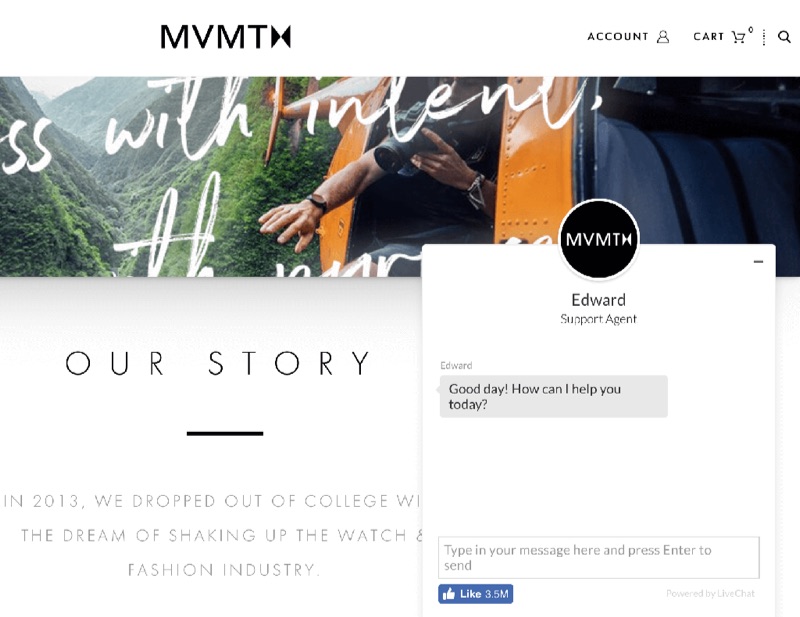
3.3. Double, then triple check local citations
The building of local citations is a keystone in local search visibility. When your business's contact information including Name, Address, Phone number (NAP) and website link are mentioned online in directories, business listings, and other websites, you will receive an increase in discoverability and awareness. However, mistakes and inaccuracies sometimes still manage to slip in, either because of human and/or program error. And once consumers notice and even suffer from these incorrect details, the downfall is ensured.
Bright Local's 2018 Local Citation Trust Report showed an astounding 93% of consumers saying they are frustrated by incorrect information in online directories. As a result, 80% of consumers lose trust in local businesses if they see incorrect or inconsistent contact details or business names online. Furthermore, in the last 12 months, 71% of consumers had a negative experience because of incorrect local business information found online. Imagine all of these happening to your business right at this moment, making customers walk out of your website without your acknowledge.
To control your local citations' credibility, first, take a deep breath and think back of where they might appear. Google comes first, as it's a fundamental local business asset to many – if not all. Check your Google My Business listing to see whether everything is correct. A simple type of mistake in your address can change your location in Google's Local Search to miles away from where it's intended to be.
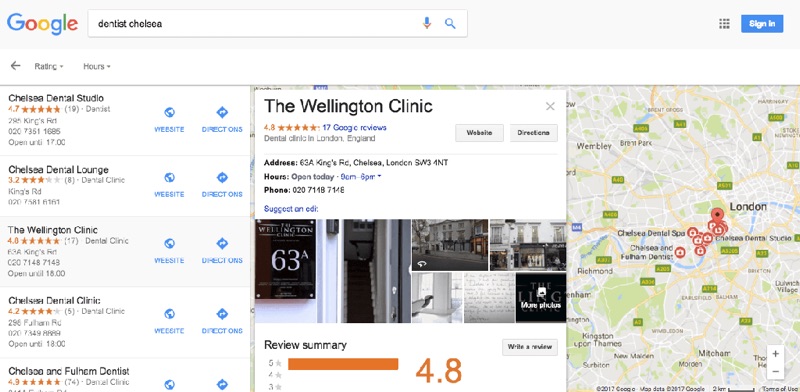
Moz's core set of quality platforms where nearly any type of local business can get their listing on include Bing, Apple Maps, Facebook, Yahoo!, Yelp, and more in their recommendation. You are also encouraged to go through all these platforms to ensure that your listing is accurate and not duplicated.
If your business pertains to a specific industry, or they belong to certain business associations and/or community hubs, head over to those platforms. For example, hotels and other hospitality industry enterprises can get listed on popular travel review websites like TripAdvisor.com; and doctors can get listed on sites like HealthGrades.com. Either admitted automatically or by past registration, don't miss out on those platforms just because you "happen to forget".
Are you business receiving/pushing for a lot of reviews and endorsement lately, especially from popular online community hubs? Then you should pay attention to how your local citations, especially your website address if you're exclusively online, are listed. It can be devastating when potentially large customer traffic is heading to your business only to be cut short because they were shown the wrong, or even nonexistent, direction.

Finally, check your website. It is the most authoritative representation of your business credibility on the internet. Be sure that your name, address, and phone number are formatted and spelled consistently any place they appear on your site. Don't overlook your header and footer, or references deep within pages of your site. If any part of your business data changes, audit your entire website to correct all references.
3.4. Make it easy to verify the accuracy of the information on your site
You can build business credibility by providing third-party support (citations, references, source material) for the information you present, especially if you link to this evidence. Even if people don't follow these links, you've shown confidence in your material.
Parissa, the US-based brand that sells natural at-home hair removal wax kits, does this right when citing credible associations and programs to fortify their commitment to produce only animal cruelty-free, environment-sustainable products.


For citations and references to third-party sites that you have a direct affiliation with, you generally won't have to worry about misinformation. However if you credit information on your website to other types of public/private resources, a double-check on their authenticity is not excessive. Many sites provide industry reports and survey reports that are relevant to your products, however consumers will only hold you accountable for what they read on your website.
3.5. Display credit badges
The first thing to do is highlight the expertise of your organization and in the content and services you provide, or establish yourself as one. Do you have experts on your team? Are your contributors or service providers authorities? Show what honest and trustworthy people stand behind your site. Be sure to give their credentials. If possible, ask their permissions to use their quotes to increase your trustworthiness.
The second question is, are you affiliated with a respected organization? If yes, make that clear. Add affiliations on being featured in articles on publications like Inc, Wired, NPR, Forbes. Conversely, don't link to outside sites that are not credible. Your site becomes less credible by association.
Especially, according to a study by CXL Institute, 42% of respondents are concerned about security at least half the time. To lift up their burden, you can add trust-inducing elements (UGC on social media posts, product review onsite or Google Listings to credit badges like BBB) to your site by showing trust badges, (company) guarantees and so on. Trust logos include privacy seals, brand association badges, or SSLs (secure sockets layers). If you are a Shopify store owner, you have probably noticed that Shopify provides an SSL certificate to all stores by default. For other stores, check with your hosting provider, as a lot of them offer this for free, for example, WordPress. Find a way so customers, especially first-time prospects, will look at one of these well-known stamps of approval on your site most "staged" naturally.
![]()
How an SSL looks
Based on a Baymard survey, 2,500 consumers entrusted Norton as the most trustworthy seal, although report also showed that they are not so hard up about which technology protects the site. The concern is realistic: Customers don't have much technical knowledge about your set-up, but they hold the sense of security that these seals provide in high regard. Meanwhile, CXL Institute reports that mong 20 popular badges, McAfee is unarguably the most loved. VeriSign, PayPal, BBB and TRUSTe run close behind.
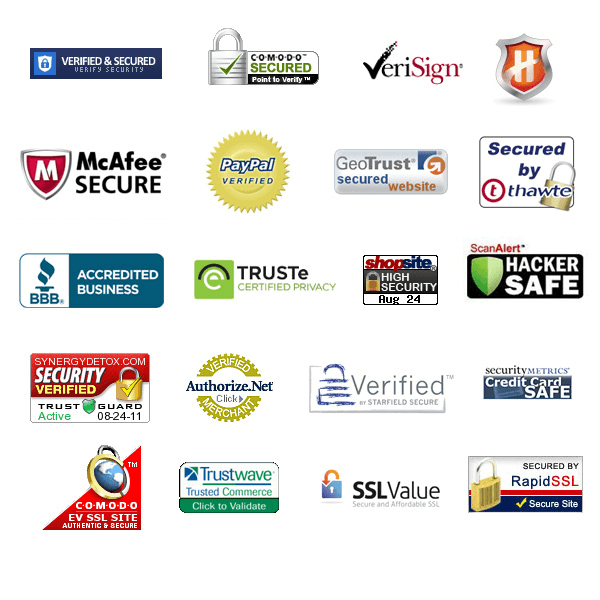

Build The Credibility for Your Shopify Store
With PageFly Landing Page Builder
Simple Drag and drop, High-quality elements.
Diverse integrations with Trust Badges apps, and Perfect page speed.
Use PageFly for FREE
Also from the same study of CXL Institute, some demographics differences are discovered:
- Generational differences
- Gen Y (aged under 30) were significantly more likely than Baby Boomers (aged 50+) to feel a Google (54% vs. 31%), Norton (54% vs. 45%), TRUSTe (31% vs. 20%) or Trusted Shops (9% vs. 3%) trust seal made them feel more secure when shopping online.
- Sitelock did well with middle age (gen x) compared to millennials
- Surprisingly Paypal was trusted by older (50+) participants relative to millennials.
- Gender differences
- Males were significantly more likely than females to trust the Visa-Mastercard seal
- Females were significantly more likely than males to feel a Norton (53% vs. 44%), BBB (43% vs. 35%) or Shopify (18% vs. 13%) trust seal made them feel more secure when shopping online.
Don't stop at online security. Go beyond and add transaction and information protection to the list too. Having the four big names below on your site definitely will make a huge difference. However, it is worth remembering that so far, there's no proof whether brand recognition leads to user behavior, or the effect of the combinations of seals.

If you're selling application, you should definitely include app store trust seals to let visitors know that your app is vetted, approved and reliable, and they can download it in App Store, Google Play, or Windows Marketplace. GoDaddy includes 2 seals (App Store and Google Play) in the footer, near the newsletter subscription form field. With this way, GoDaddy let visitors know that they can place trust in them, and choose to interact with them via company app.

BellaCor made an experiment with bonds and they found out that visitors who saw buySafe's seal and bonding option were 10.4% more likely to make a purchase than consumers who did not see the seal. Oriental Furniture added a buySafe seal to their website. They checked this against the control that didn't have the seal. After a couple of months of testing, Oriental Furniture experienced a 7.6% bump in conversion rate. Express Watches is a UK based online seller of Seiko watches. They A/B tested on whether customers cared more about price or authenticity. The authenticity variation increased sales by 107% compared to the original.

Use credit badges and trust seals wisely, because every praise you receive in your business journey, regardless of how small or insignificant a role they might play, is something which can add value to your credibility, or make a rotten impact. The more high-quality endorsements and testimonials you have from other successful professionals, the better it speaks to your own credibility.
3.6. Establish clear policies
As new customers, people are skeptical and guarded. Take away the cautious instincts before they have the chance to think about it. For example, if you run a clothing store, your customers may be worried about unfit size, not suitable when trying on, or wasted money on delivery.

Hugo Boss aces this task by immediately telling customers that they can return the item for free. Plus, they will change it if customers want. The risk and anxiety is gone.
3.7. Have a FAQ Page
One of the pages that we often overlook when creating an online store is the FAQ page, without realizing its true value in building trust and business credibility. Having a well-written FAQ page can actually help convert visitors to customers, especially if they still have doubts about your product.
Make it easy for customers to find the important information on your website. Customers are often looking for a lot of the same information such as shipping, return policy, etc. and having a FAQ page can help decrease customer confusion and customer service requests. Walk-in your customers' shoes: If you don't want to get a migraine from the mayhem that is a badly organized FAQ page, then neither do your customers. To counter this problem, you can batch questions together by category to increase efficiency and answer user questions before users even realize they need to ask. Pivotal tracker among many others use this tactic to turn their 100-question FAQ page into a neat knowledge resource.
![]()
Providing permanent and specific URLs for returning to the exact place where a question is answered is also another way in which you show consideration to your customers, especially those who are doing evaluative research on your product. Pivotal Tracker's FAQ page makes it that when visitors reach a specific question, an element ID will automatically be generated in the URL. Visitors will then have an easy copy and paste URL to share as needed.
Another crucial reminder is to keep it simple. "It" here is the language, the technical jargons, the length you go into answering a question as detailed and precisely as possible. Keeping this mistakes will make your FAQ page become boring very quickly and hard to process. Don't make your answers raise more questions, but instead turn it into the anchor landing your customers to their purchase.
Benchmark against other websites in your industry to see what they are including on their FAQ page. Make your FAQ page easily accessible – header or footer of your website – and include a contact link just in case the customer doesn't find what they are looking for!
3.8. Update your site's content often
Or at least, show it's been reviewed recently. Outdated content can hurt your business credibility.
Avoid errors of all types, no matter how small they seem. Having a website with spelling errors, bad images, and poor design is worse than having no web site at all. Encourage your customers to bring errors to your attention. Your customers can provide you with feedback as they browse your site, and you can quickly make the necessary changes. Typographical errors and broken links hurt a site's credibility more than most people imagine. It's also important to keep your site up and running.
Comb your site so it's "mistake-proof". Grammarly is a great tool to catch any stray errors for your content. Broken links and poor graphics can also look sloppy and unprofessional. They kill trust in a split second, so don't ignore them.
3.9. Restrain from promotional content
If possible, avoid having ads on your site. If you must have ads, clearly distinguish the sponsored content from your own. Avoid pop-up ads, unless you don't mind annoying users and losing credibility. As for writing style, try to be clear, direct, and sincere.
04. Strategies To Strengthen Business Credibility
4.1. Website
Besides important notes like your website and providing high-quality, certified products, you should extend your credibility on a wider scale. However, there are some specific places in your website that can greatly improve customer trust and quickly boost credibility for you. Moving trust seals closer to important or first-impression sections can well assure customers when they are sitting on the fences or entering sensitive information. Some recommended locations that trust seals can be displayed are:
- Header and/or footer. Adlift landing page showcases a trust seal in the headline, making it visible to potential clients right away. It's also in close proximity to two actionable items — above the form and next to the phone number:
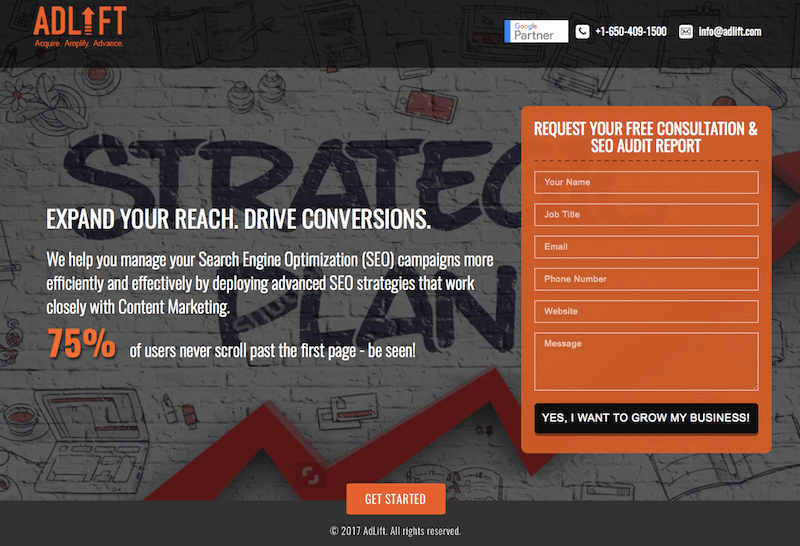
- Near a form: Iterable landing page shows customer logos centered below the lead capture form. Doing this helps reassure and remind prospects that established, reputable brands such as Yelp and Zillow trust Iterable for their email marketing:

The big shark Salesforce applies this technique seamlessly in their landing page too:
- In the checkout page, put trust seals as close to payment section as possible.
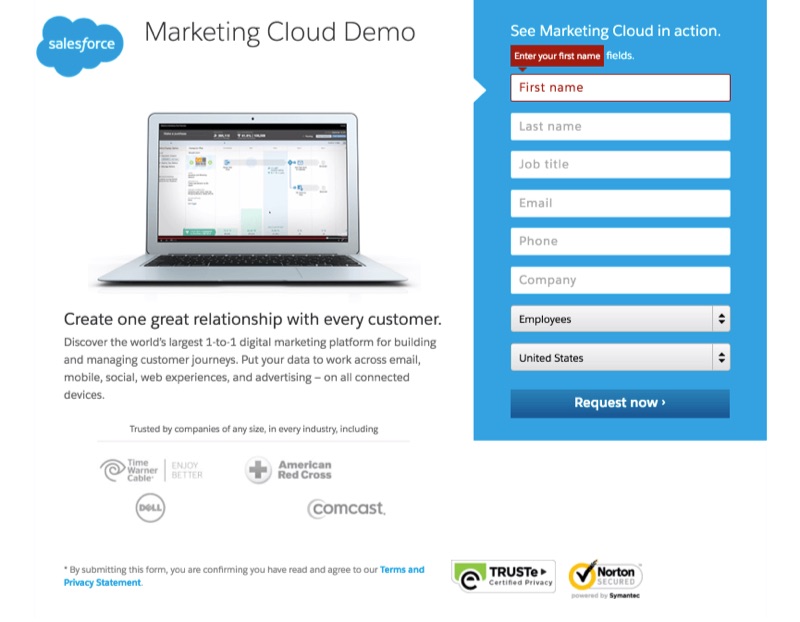
4.2. Brand
Beyond the fundamentals of providing quality and consistent goods and services and ensuring that a company is behaving responsibly by respecting the environment and human rights, there are some key steps to earn business credibility and customer trust that business leaders and companies can take.
Be proactively transparent – about what they do, how they do it and how they contribute to the society.
Transparency allows the public – acting as watchdogs – to seamlessly check claims of responsibility or sustainability – and enables them to act as early warning systems alerting brands to problems. Now there are already brands leading in the way in key areas – publishing supply chains (such as Nike, Puma, Adidas, etc.), disclosing more beneficial ownership information and group structures (such as Unilever and Natura), publishing tax policies, practices and payments (such as BHP Billiton, LUSH or Vodafone), setting out policies around political engagement (such as Visa and GSK), and promoting fair labor practices (like Patagonia). If you are skeptical of business transparency, I can tell you leading brands believe it benefits them to invest the effort in doing it.

Secondly, companies and CEO can build trust by putting real support behind efforts to improve the well-being of people and planet. This means going beyond what is expected or minimum standards, to work together, with civil society and sometimes with governments, to address urgent challenges. It can mean to support ending anonymous companies, or to commit seriously to shift business models towards a net zero carbon economy, or or to stand up for human rights. At a time when many countries restrict people's rights to speak out and associate in civil tasks, the need for business leadership that supports democracy and civic rights, in particular, is more urgent than ever.
4.3. Reputation
Brand and business credibility are intertwined. Be consistent. Everything you do, say and think should be consistent. The messages you're sending out, the actions you take, and the things you allow into your heart and mind – the thoughts should all be in total alignment with who you are and what you do. Credibility only happens when everything is consistent, from the inside out.
Be genuine. You need authenticity to cultivate credibility; when you're trying to win trust, you can't rely on the "fake it till you make it" approach. The basis for establishing your business or your leadership is a solid foundation that provides tremendous, lasting stability, no matter what changes may be ahead.
Be sincere. Being credible means being sincere. It means you don't say everything you think, but you mean everything you say. You cannot claim it; you just have to be it. to Sincerity requires commitment and dedication and the willingness to be steadfast, unmovable and always straightforward–no matter what.
Be respectful. Holding other people's feelings in respect may mean nothing to you, but it could mean everything to them. Treat everyone with respect–not because you expect something, but because you know they deserve it. Titles are granted, positions are given, but it's respect that earns you credibility.
Start with a commitment to take time to build your network, try to make a difference, shine a light on others and work harder on having real conversations. You'll be surprised how much these simple efforts will improve your social media presence in the long run and your brand's business credibility too. Look for ways to make a difference and shine a light on others too. Don't make your social media efforts all about you. Here's a tip: Pick a few people from your followers and connections and highlight them. Share and promote content they've shared or just give them a shout out. Leverage trends like Follow Friday on Twitter to send shout outs to those you appreciate – just because.

Be more social, have a conversation. Listen to the conversations others are having. Answer their questions if you can. Quora and Reddit are great places to start. Take part in brainstorming sessions when others are seeking ideas. Ask questions of your own. Build connections and trust. Connecting and showing interest in others on social media will help you build a stronger and more effective network and will help you more effectively spread your message when the time is right.
In Conclusion
If you are early in online business, you probably lack achievements, endorsements and experience necessary to build business credibility. Despite this fact, find your confidence. If you are endeavoring to be an entrepreneur, you already have established trust above millions of individuals who lack the confidence to even try. Be proud of yourself. The process to establish your own marks can take years of hard work and diligent execution. Take as much care to protect your credibility as you do establish it.
Business credibility is a firm stepping stone for purchase, so prepare slowly but powerfully. Most business owners have to start at the bottom with no sales or social proof to leverage. Building credibility takes real commitment. Credible companies are not created overnight. It is a process with many components. To build a great business, you have to set standards, and you have to live by them. It is an ever-evolving part of your business strategy. With these tactics, hopefully, you're now in a better position to win that juicy deal and work your way up to an inspiring reputation.
Related article: Profitable eCommerce Model You Might Miss Out On
What Is Credibility In Business
Source: https://academy.pagefly.io/guide/build-business-credibility-trust/
Posted by: zurcherpudge1936.blogspot.com

0 Response to "What Is Credibility In Business"
Post a Comment